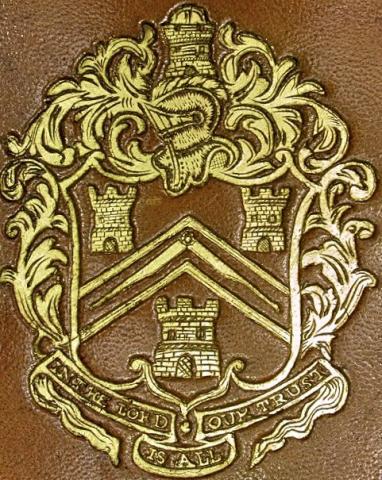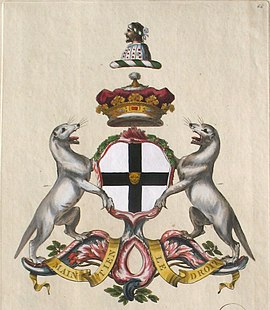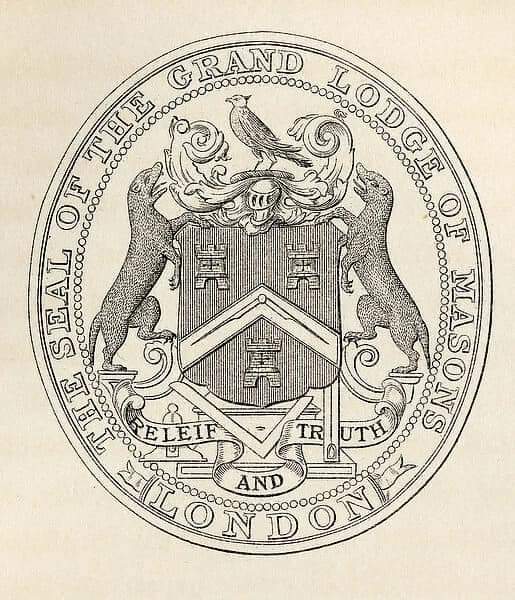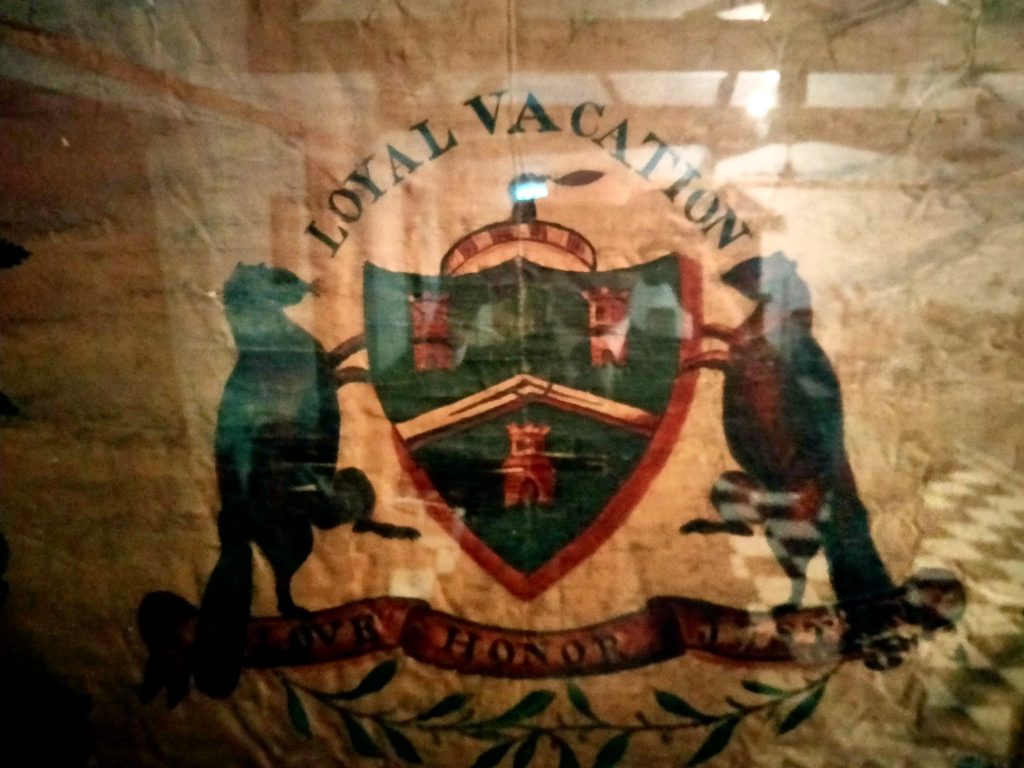“. . and the Derivation of our Most Antient Banner”
The depiction of “Three Castles” have been a symbol of Dublin City since circa 1230 when they first appeared on a city seal as three towers situated around one of the fortified gates of the city. Over time, the towers assumed greater significance as a symbol and were later separated into three distinct castles. It is a matter of speculation therefore that the Coat of Arms of the Mason’s Company of London dates its rise to the sojourning Masons of the City of Dublin, but there is no evidence to support this speculation save the Coat of Arms design.

Mason’s Company of London (1473)
The Worshipful Company of Masons, more commonly known as the Masons Company, is one of the City of London’s oldest Livery Companies with records dating back to 1356. The arms were granted in 1473, the crest painted but not blazoned. They were confirmed in 1521 and entered at the Visitation of London in 1534.
With the Renaissance (from 1300 to the beginning of the 1600’s), the Church’s power waned and the intellectual position of stonemasonry began to change; geometry was slipping as the dominant “power science.” Also, many of the key players of scientific thought were (speculative) Freemasons. These same individuals were instrumental in establishing the English “Royal Society.” This institution was not only influenced and populated by Freemasons; it was endorsed and financed by royalty. This was the age of free thought.
After the Great Fire at London of 1666, a great part of the City from Blackfriars to London Bridge had been destroyed and a great many Architects, Builders, and Masons were drawn to London from all parts of the country to assist in the work of rebuilding the City and in the restoration of St. Paul’s Cathedral. The natural consequence was that the London Lodges developed great activity over the next fifty years (two generations), whilst some of the old Lodges around the country, declined.
The Masons Company was formally incorporated under a Royal Charter in 1677 and ranks thirtieth in the order of precedence of Livery Companies. Its original role was to safeguard the welfare of its members, and to regulate the craft of stonemasonry, so that standards could be properly maintained.

Chandos Coat of Arms circa. (1730)
Animals
The heraldic animals on left and right have been a source of discussion for some time with some believing them to be beavers and some ferrets. Research indicates that they are in fact otters and stand rampant Sinister and Dexter (left and right) in the family Arms.
Henry, 2nd Duke of Chandos became Grand Master in 1738 and it seems apparent that he allowed the Grand Lodge of Masons to adopt HIS coast of Arms in perpetuity rather than change it as the Grand Master changed.

Seal of the Grand Lodge of Masons (1717)
The Arms granted to the Mason’s Company of London is replicated, but the animals from the Chandos Coat of Arms are adopted “rampant Sinister and Dexter” (left and right) in the seal and a bird of prey replaces the man.
The Chandos family shield (leopard’s head on a black cross) has been replaced with the City of London shield bearing a pair of compasses on a chevron with three castle turrets. The crown is removed, but the Agal (headband) remains and the man facing left has been replaced with a bird of prey facing left.
The organisation now known as the Premier Grand Lodge of England was founded on 24 June 1717 as the Grand Lodge of London and Westminster. Originally concerned with the practice of Freemasonry in London and Westminster, it soon became known as the Grand Lodge of England. Because it was the first Masonic Grand Lodge to be created, modern convention now calls it the Premier Grand Lodge of England in order to distinguish it from the Most Ancient and Honourable Society of Free and Accepted Masons according to the Old Constitutions, usually referred to as the Ancient Grand Lodge of England, and the Grand Lodge of All England Meeting at York. It existed until 1813, when it united with the Ancient Grand Lodge of England to create the United Grand Lodge of England.
The basic principles of the Grand Lodge of England were inspired by the ideal of tolerance and universal understanding of the Enlightenment and by the Scientific Revolution of the 17th century.
This would also explain why the Lodge number having been renumbered from 163 (in 1729) to 148, 91, 75 59 and finally 55 (in 1792) then increases to 76 in 1814 then 67 in 1832 as the Lodge became governed by the constitutions of the United Grand Lodge of England.

York Grand Lodge (circa. 1730)
A hand holding a trowel now replaces the bird of prey.
On 27th December 1725, (the feast of St. John the Evangelist), the York lodge claimed the status of a Grand Lodge. The burst of activity, which started earlier that year, may have been occasioned by the circulation of Anderson’s constitutions and the formation of a lodge at Durham under the jurisdiction of the London Grand Lodge. The minutes of 10th August 1725 describe William Scourfield as Worshipful Master. On 27 December, Brother Charles Bathurst was elected as Grand Master. One of his wardens was Francis Drake (the antiquarian) who had only been initiated in September of that year. This occurred after a procession to Merchant’s Hall, York and a banquet. They described themselves as a “society and fraternity of free Masons“. In 1726, Drake delivered a speech which was written down. He characterised Freemasonry with the attributes of “Brotherly love, relief, and truth”, and claimed superiority over the Southern Grand Lodge. They were, he said, content that the London lodge have the title Grand Master of England, but York claimed Totius Angliae (All England). The master of 1724, W.Bro. Scourfield, was expelled for making masons irregularly. Drake’s speech used the York Legend to claim precedence over all other English lodges, as the first lodge was established under Edwin of Northumbria around the year 600. Here, Edwin was not the brother or son of Athelstan and the first lodge thereby became over three centuries older. Drake refers to three classes of Freemasons, working masons, other trades, and Gentlemen. Nineteen rules were enacted as Constitutions and meetings moved from private houses to taverns.
After a gap, the next minutes are from 21st June 1729. The minutes then become scarce or lost. In 1734 some masons travelled south to obtain authorisation for a lodge in York under the jurisdiction of the London Grand Lodge.
It was not until 1761 that the Grand Lodge was revived, under the Grand Mastership of Drake, for a period of renewed and more successful activity. In 1767, they wrote to London informing them that their lodge No 259, in Stonegate, York, had ceased to meet, telling them; “This Lodge acknowledges no superiors and owes subjection to none; she exists in her own right, giving Constitutions and Certificate, in the same way as the Grand Lodge of England in London has asserted her claims there from time immemorial.” On 31st July 1769, constitutions were granted to the Royal Oak lodge in Ripon and on 30 October of the same year, Brothers Cateson, Revell, and Ketar were advanced to the degree of Master Mason, before being granted a constitution for the Crown in Boroughbridge. The Royal Arch Degree was introduced in 1768, and “Knights-Templars” by 1780. In 1777 London opened the Union lodge in York, but after negotiations during 1778, the rebel half of Antiquity were accepted in 1779 as the “only regular lodge in London”. Antiquity, London’s oldest and most prestigious lodge, had split following a dispute with their own Grand Lodge, who interpreted a walk from church to lodge in regalia by a few of their members as an unauthorised procession. At the centre of the controversy was Scottish editor William Preston, who mediated the move. These London Masons became, for ten years, The Grand Lodge of All England South of the River Trent.
The last minute is from 23 August 1792. Woodford postulated that the lodge didn’t cease to exist but that it was simply absorbed by the larger Grand Lodge. Unlike other Grand Lodges, it enacted all the functions of a private lodge, as well as any regulatory duties that may have arisen.

Vacation Lodge (circa. 1730)
The banner currently located in the main temple at Wiveliscombe is entitled “Loyal Vacation” and bears in every major detail, the coat of Arms of the York Grand Lodge. However, the word ‘Loyal’ was only added to the Lodge’s name in 1802 when King George IV was Grand Master, the two Grand Lodges were being ‘combined’ and the Loyal Vacation Lodge was relocated from London to Wiveliscombe, so the banner was clearly created after this date. York Grand Lodge had by then already fallen into decay and had ceased to be around 1793, which leads us to the conclusion that the banner is indeed an updated replica of another older banner, now potentially lost.
This would also explain why the Lodge number having been renumbered from 163 (in 1729) to 148, 91, 75 59 and finally 55 (in 1792) then increases to 76 in 1814 then 67 in 1832 as the Lodge was then governed by the constitutions of the United Grand Lodge of England.
Sadly, despite trying a move from Wiveliscombe some 15 miles west to Dulverton in 1854, the lodge Warrant was returned some six years later on 14th May 1862 and the Lodge ceased.
![]()
